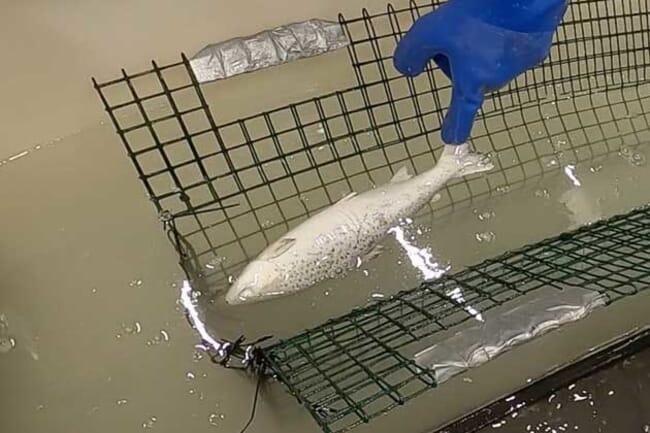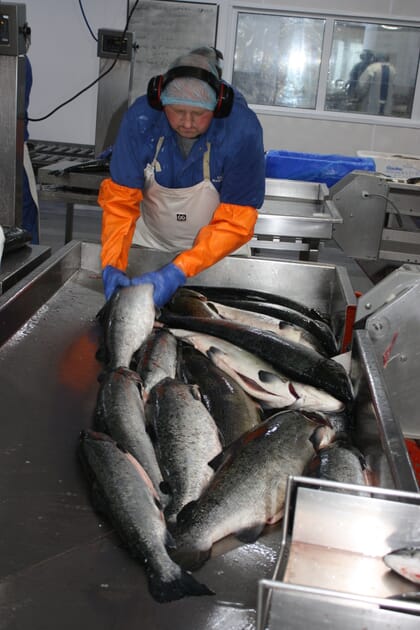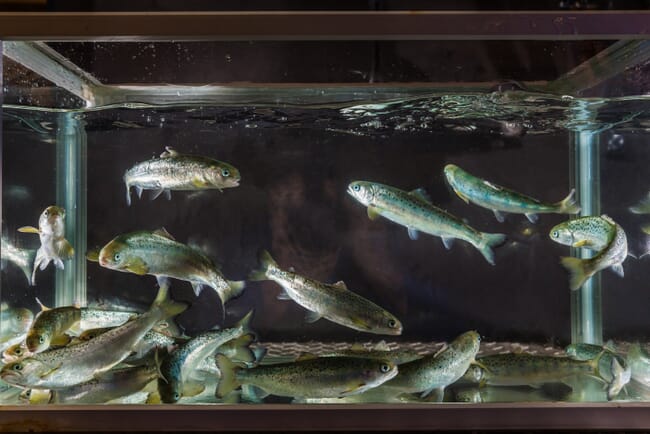
The aquaculture industry is trying to identify new humane handling methods © Nofima
When a live fish is handled, it can become stressed. If fish are stressed when they are slaughtered, it can negatively impact the finished quality of the product. This stress also raises welfare concerns – the fish should not suffer when they are slaughtered.
Requirements for stunning salmon ready for slaughter
The well-being of animals is the basis for all farming. The Norwegian Animal Welfare Act is in place to ensure that animals are treated well in captivity, and that they experience the least suffering possible during slaughtering. This also applies to fish. When farmed salmon are slaughtered, the fish need to be sedated first so that they do not experience any pain, fear, or significant discomfort until they go unconscious and are slaughtered.
The Animal Welfare Act requires that salmon slaughterhouses use a method of stunning where the fish lose consciousness in less than half a second. The requirement allows slaughterhouses to choose between electrical stunning or using a hard blow to the head.

Current welfare regulations state that salmon slaughterhouses must use a method of stunning where the fish lose consciousness in less than half a second
Even though most salmon are stunned using these methods, there are situations where the blow is not strong enough, or that the electrical stunning does not work as intended and the fish are injured but not unconscious. We do not know precisely how many fish this affects, but the margins of error result in additional work and significant costs, both financially and in terms of animal welfare. The aquaculture industry is looking for new or improved methods to ensure that all fish are properly sedated before being slaughtered.
Three salmon in supercooled baths
Every day, Nofima researcher Svein Kristian Stormo works with fish that have already been slaughtered, and especially on the topic freezing and thawing fish. He came up with a hypothesis that a quick, cold bath using supercooled brine might be able to stun the salmon in a simpler and safer manner. Brine can be cooled and remain a liquid to as cold as minus 20 degrees Celsius, and the fish would also be underwater while being stunned.
Stormo, on behalf of the Norwegian Seafood Research Fund, applied for permission from the Norwegian Food Safety Authority to carry out this experiment on salmon that were ready for slaughter. There are tough restrictions regarding subjecting animals to discomfort in a research context. Due to the expected strain on the fish, permission was only granted for a preliminary study using three fish. Furthermore, the three fish had to weigh less than one kilogram – significantly below the normal slaughter weight of 3-4 kilograms. They could only be exposed to the ultra-cool brine for two seconds, with an option for a further 13 seconds if the fish was not writhing or moving its gill covers.
The researchers set everything up, and carefully placed the three salmon in the brine. The first one was knocked out immediately, while the other two displayed movement during the two seconds they were in the brine.
“Despite being a very limited preliminary study, where we couldn’t really draw any major conclusions since we tested on so few fish, we still wanted to explore the idea further to get more information,” says Stormo.
Testing on small wild fish
Since the requirements for experimenting on wild fish are less strict, the researchers applied once again and were granted permission to test the concept on small fish of under 500 grams. Three groups of eight fish were used for the experiment. Two groups were exposed to the cold brine for 30 seconds, with one group being euthanised immediately afterwards, while the other was put into regular seawater to wake up again. The third group, the control group, were placed in a cage in seawater for 45 seconds, corresponding to the time needed for the handling and treatment of the first group.
The fish calmed down very quickly once they were placed in the cold brine of minus 18 degrees Celsius. The researchers observed the fish for a total of thirty seconds, even though it was only practical to study the fish in detail during the final half.
“We made interesting observations in this concept test. Some fish were so knocked out that they lost their balance and stopped moving, while most became drowsy and had weak muscle and gill movements,” Stormo explains.
Unknown if the fish were stunned
This was an experimental trial of a very limited scope in an entirely new area in fish stunning. It was not possible to confirm whether, and to what extent, the fish were stunned by being placed in ultra-cool brine. It was not possible to attach electrodes to the fish. Nevertheless, Stormo and his colleagues were able to make some interesting observations.
“If the fish experienced discomfort during the process, we would expect to see an acute flight response. This can be observed when fish are in warm water or receive an overdose of benzoak, which is the regulation slaughter method for fish trials. We saw no evidence of this sort of response. In less than a minute in normal seawater, the fish began to swim around like normal again,” says Stormo.
The researchers also measured the levels of the stress hormone cortisol but found no increase after the treatment. However, higher levels of cortisol were registered after transport.

It was not possible to confirm whether, and to what extent, the fish were stunned by being placed in ultra-cool brine © Terje Aamodt, Nofima
Desire to research further on wild fish
The researchers could also only use very limited number of fish weighing under 500 grams. How salmon ready for slaughter weighing 4-5 kilograms will react to the process is not something the researchers can comment on. Nevertheless, they see the method as interesting, and believe it has potential – but not for farmed salmon at this point.
“The requirement that fish should be stunned in under half a second won’t be met using ultra-low temperatures. Even if no fish show any sign of panic when they are placed in the stunning tank, it still took several seconds before we could see that the fish were totally “knocked out”. Despite the fact that the method isn’t particularly quick, we believe it may have potential to improve the handling of other species,” says Stormo.
Wild fish are often slaughtered on board vessels, without stunning. Certain species that are fished in large quantities without individual handling, such as herring and shellfish may be targets for this sort of stunning method.
“Shrimp are caught on board and are sent straight from the net to the pan, or slowly frozen. If they could be placed in supercooled brine, they would be stunned and frozen in a single operation. It would be interesting to investigate further and get documented,” says Stormo.




